Research on Vegetation Cover Changes in Arid and Semi-Arid Region Based on a Spatio-Temporal Fusion Model
Abstract
1. Introduction
2. Materials and Methods
2.1. Study Area
2.2. Data Source and Pre-Processing
2.3. Research Methods
2.3.1. ESTARFM Spatiotemporal Fusion MODEL
2.3.2. FVC Estimation
2.3.3. Accuracy Verification
2.3.4. Annual Variation Trend of FVC
3. Results
3.1. ESTARFM Model Fusion Results
3.2. FVC Accuracy Verification
3.3. Temporal and Spatial Variation Characteristics of FVC
3.4. Slope Change Trend of FVC
3.5. Distribution and Variation Characteristics of FVC with Terrain
3.5.1. Distribution and Variation Characteristics of FVC with Altitude
3.5.2. Distribution and Variation Characteristics of FVC with Slope
3.5.3. Distribution and Variation Characteristics of FVC with Direction
4. Discussion
5. Conclusions
Author Contributions
Funding
Data Availability Statement
Acknowledgments
Conflicts of Interest
Appendix A
| Date Acquired | Sensor | Spatial Resolution | Path/Row | Landsat Scene Identifier |
|---|---|---|---|---|
| 14 August 2006 | TM | 30 m | 146/030, 146/031 | LT51460302006226IKR00, LT51460312006226IKR00 |
| 17 August 2007 | TM | 30 m | 146/030, 146/031 | LT51460302007229IKR00, LT51460312007229IKR00 |
| 3 August 2008 | TM | 30 m | 146/030, 146/031 | LT51460302008216KHC01, LT51460312008216KHC01 |
| 11 July 2011 | TM | 30 m | 146/030, 146/031 | LT51460302011192IKR02, LT51460312011192IKR02 |
| 22 August 2012 | ETM+ | 30 m | 146/030, 146/031 | LE71460302012235PFS00, LE71460312012235PFS00 |
| 1 August 2013 | OLI | 30 m | 146/030, 146/031 | LC81460302013213LGN02, LC81460312013213LGN02 |
| 19 July 2014 | OLI | 30 m | 146/030, 146/031 | LC81460302014200LGN01, LC81460312014200LGN01 |
| 9 August 2016 | OLI | 30 m | 146/030, 146/031 | LC81460302016222LGN01, LC81460312016222LGN01 |
| 15 August 2018 | OLI | 30 m | 146/030, 146/031 | LC81460302018227LGN00, LC81460312018227LGN00 |
| 17 July 2019 | OLI | 30 m | 146/030, 146/031 | LC81460302019198LGN00, LC81460312019198LGN00 |
| 4 August 2020 | OLI | 30 m | 146/030, 146/031 | LC81460302020217LGN00, LC81460312020217LGN00 |
| Date Acquired | Product Type | Spatial Resolution | Horizontal/Vertical Tile Number | Entity Identifier |
|---|---|---|---|---|
| 13 August 2006 | MOD09A1 | 500 m | h23v04 | MOD09A1.A2006225.h23v04.006 |
| 13 August 2007 | MOD09A1 | 500 m | h23v04 | MOD09A1.A2007225.h23v04.006 |
| 4 August 2008 | MOD09A1 | 500 m | h23v04 | MOD09A1.A2008217.h23v04.006 |
| 12 July 2011 | MOD09A1 | 500 m | h23v04 | MOD09A1.A2011193.h23v04.006 |
| 20 August 2012 | MOD09A1 | 500 m | h23v04 | MOD09A1.A2012233.h23v04.006 |
| 28 July 2013 | MOD09A1 | 500 m | h23v04 | MOD09A1.A2013209.h23v04.006 |
| 20 July 2014 | MOD09A1 | 500 m | h23v04 | MOD09A1.A2014201.h23v04.006 |
| 12 August 2016 | MOD09A1 | 500 m | h23v04 | MOD09A1.A2016225.h23v04.006 |
| 13 August 2018 | MOD09A1 | 500 m | h23v04 | MOD09A1.A2018225.h23v04.006 |
| 20 July 2019 | MOD09A1 | 500 m | h23v04 | MOD09A1.A2019201.h23v04.006 |
| 4 August 2020 | MOD09A1 | 500 m | h23v04 | MOD09A1.A2020217.h23v04.006 |
References
- Dixon, R.K.; Brown, S.; Houghton, R.A.; Solomon, A.M.; Trexler, M.C.; Wisniewski, J. Carbon pools and flux of global forest ecosystems. Science 1994, 263, 185–190. [Google Scholar] [CrossRef] [PubMed]
- Sitch, S.; Smith, B.; Prentice, I.C.; Arneth, A.; Bondeau, A.; Cramer, W.; Kaplans, J.O.; Levis, S.; Lucht, W.; Sykes, M.T.; et al. Evaluation of ecosystem dynamics, plant geography and terrestrial Carbon cycling in the LPJ dynamic global vegetation mode. Glob. Change Biol. 2003, 9, 161–185. [Google Scholar] [CrossRef]
- Wu, X.R.; Guo, P.; Sun, Y.Q.; Liang, H.; Zhang, X.G.; Bai, W.H. Recent Progress on Vegetation Remote Sensing Using Spaceborne GNSS-Reflectometry. Remote Sens. 2021, 13, 4244. [Google Scholar] [CrossRef]
- Hao, J.W.; Chu, L.M. Vegetation Types Attributed to Deforestation and Secondary Succession Drive the Elevational Changes in Diversity and Distribution of Terrestrial Mosses in a Tropical Mountain Forest in Southern China. Forests 2021, 12, 961. [Google Scholar] [CrossRef]
- Parmesan, C.; Yohe, G. A globally coherent fingerprint of climate change impacts across natural systems. Nature 2003, 421, 37–42. [Google Scholar] [CrossRef]
- Yu, L.X.; Yan, Z.R.; Zhang, S.W. Forest Phenology Shifts in Response to Climate Change over China–Mongolia–Russia International Economic Corridor. Forests 2020, 11, 757. [Google Scholar] [CrossRef]
- Notaro, M.; Mauss, A.; Williams, J.W. Projected vegetation changes for the American Southwest: Combined dynamic modeling and bioclimatic-envelope approach. Ecol. Appl. 2012, 22, 1365–1388. [Google Scholar] [CrossRef]
- Yang, X.C.; Xu, B.; Jin, Y.X.; Qin, Z.H.; Ma, H.L.; Li, J.Y.; Zhao, F.; Chen, S.; Zhu, X.H. Remote sensing monitoring of grassland vegetation growth in the Beijing–Tianjin sandstorm source project area from 2000 to 2010. Ecol. Indic. 2015, 51, 244–251. [Google Scholar] [CrossRef]
- Wang, J.; Xie, Y.W.; Wang, X.Y.; Guo, K.M. Driving factors of recent vegetation changes in Hexi Region, Northwest China based on a new classification framework. Remote Sens. 2020, 12, 1758. [Google Scholar] [CrossRef]
- Hill, M.J.; Guerschman, J.P. Global trends in vegetation fractional cover: Hotspots for change in bare soil and non-photosynthetic vegetation. Agric. Ecosyst. Environ. 2022, 324, 107719. [Google Scholar] [CrossRef]
- Gitelson, A.A.; Kaufman, Y.J.; Stark, R.; Rundquist, D. Novel algorithms for remote estimation of vegetation fraction. Remote Sens. Environ. 2002, 80, 76–87. [Google Scholar] [CrossRef]
- Zhang, J.; Walsh, J.E. Relative impacts of vegetation coverage and leaf area index on climate change in a greener north. Geophys. Res. Lett. 2007, 34, L15703. [Google Scholar] [CrossRef]
- Song, Y.F.; Guo, Z.X.; Lu, Y.J.; Yan, D.H.; Liao, Z.L.; Liu, H.W.; Cui, Y.J. Pixel-Level Spatiotemporal Analyses of Vegetation Fractional Coverage Variation and Its Influential Factors in a Desert Steppe: A Case Study in Inner Mongolia, China. Water 2017, 9, 478. [Google Scholar] [CrossRef]
- Smith, A.M.S.; Kolden, C.A.; Tinkham, W.T.; Talhelm, A.F.; Marshall, J.D.; Hudak, A.T.; Boschetti, L.; Falkowski, M.J.; Greenberg, J.A.; Anderson, J.W.; et al. Remote sensing the vulnerability of vegetation in natural terrestrial ecosystems. Remote Sens. Environ. 2014, 154, 322–337. [Google Scholar] [CrossRef]
- Liu, D.Y.; Jia, K.; Jiang, H.Y.; Xia, M.; Tao, G.F.; Wang, B.; Chen, Z.L.; Yuan, B.; Li, J. Fractional Vegetation Cover Estimation Algorithm for FY-3B Reflectance Data Based on Random Forest Regression Method. Remote Sens. 2021, 13, 2165. [Google Scholar] [CrossRef]
- Phiri, D.; Morgenroth, J. Developments in Landsat Land Cover Classification Methods: A Review. Remote Sens. 2017, 9, 967. [Google Scholar] [CrossRef]
- Wang, Y.L.; Li, M.S. Annually Urban Fractional Vegetation Cover Dynamic Mapping in Hefei, China (1999–2018). Remote Sens. 2021, 13, 2126. [Google Scholar] [CrossRef]
- Wen, G.C.; Zhao, M.J.; Xie, H.B.; Zhang, Y.; Zhang, j. Analysis of land vegetation cover evolution and driving forces in the western part of the Ili River Valley. Arid Zone Res. 2021, 38, 843–854. [Google Scholar]
- Li, H.M.; Bahejiayinaer, T.; Chang, S.L.; Zhang, Y.T. Spatial-temporal change and prediction analysis of vegetation coverage in the northern slope of Tianshan Mountains in 30 years. Chin. J. Ecol. 2022, 1–15. Available online: http://kns.cnki.net/kcms/detail/21.1148.q.20220526.1759.025.html (accessed on 16 November 2022).
- Chang, M.D.; Wang, X.J.; Yan, L.N.; Ma, K.; Li, Y.K.; Li, J.Y.; Jia, H.T. Temporal and spatial pattern dynamic variations of vegetation cover and management factors in the middle of the northern slope of Tianshan Mountains. J. Agric. Res. Environ. 2022, 39, 836–846. [Google Scholar]
- Cai, C.C.; Huai, Y.J.; Bai, T.; Dong, L. Recent Changes of Grassland Cover in Xinjiang Based on NDVI Analysis. J. Basic Eng. 2020, 28, 1369–1381. [Google Scholar]
- Yin, Z.L.; Feng, Q.; Wang, L.G.; Chen, Z.X.; Chang, Y.B.; Zhu, R. Vegetation coverage change and its influencing factors across the northwest region of China during 2000–2019. J. Desert Res. 2022, 42, 11–21. [Google Scholar]
- Wang, H.J.; Li, Z.; Niu, Y.; Li, X.C.; Cao, L.; Feng, R.; He, Q.N.; Pan, Y.P. Evolution and Climate Drivers of NDVI of Natural Vegetation during the Growing Season in the Arid Region of Northwest China. Forests 2022, 13, 1082. [Google Scholar] [CrossRef]
- Li, X.W.; Zulkar, H.; Wang, D.Y.; Zhao, T.N.; Xu, W.T. Changes in Vegetation Coverage and Migration Characteristics of Center of Gravity in the Arid Desert Region of Northwest China in 30 Recent Years. Land 2022, 11, 1688. [Google Scholar] [CrossRef]
- Mu, B.; Zhao, X.; Wu, D.H.; Wang, X.Y.; Zhao, J.C.; Wang, H.Y.; Zhou, Q.; Du, X.Z.; Liu, N.J. Vegetation Cover Change and Its Attribution in China from 2001 to 2018. Remote Sens. 2021, 13, 496. [Google Scholar] [CrossRef]
- Gao, F.; Masek, J.; Schwaller, M.; Hall, F. On the blending of the Landsat and MODIS surfaces reflectance: Predicting daily Landsat surface reflectance. IEEE Tran. Geosci. Remote Sens. 2006, 44, 2207–2218. [Google Scholar]
- Zhu, X.L.; Chen, J.; Gao, F.; Chen, X.H.; Masek, J.G. An enhanced spatial and temporal adaptive reflectance fusion model for complex heterogeneous region. Remote Sens. Environ. 2010, 114, 2610–2623. [Google Scholar] [CrossRef]
- Wu, G.J.; Liu, X.H.; Kang, S.C.; Chen, T.; Xu, G.B.; Zeng, X.M.; Kang, H.H. Age-dependent impacts of climate change and intrinsic water-use efficiency on the growth of Schrenk spruce (Picea schrenkiana) in the western Tianshan Mountains, China. For. Ecol. Manag. 2018, 414, 1–14. [Google Scholar] [CrossRef]
- Jarihani, A.A.; Mcvicar, T.R.; Vanniel, T.G.; Emelyanova, I.V.; Callow, J.N.; Johansen, K. Blending Landsat and MODIS data to generate multispectral indices: A Comparison of “Index-then-Blend” and “Blend-then-Index” approaches. Remote Sens. 2014, 6, 9213–9238. [Google Scholar] [CrossRef]
- Xiao, J.F.; Moody, A. A comparison of method for estimating fractional green vegetation cover within a desert-to-upland transition zone in central New Mexico, USA. Remote Sens. Environ. 2005, 98, 237–250. [Google Scholar] [CrossRef]
- Qi, J.; Marsett, R.C.; Moran, M.S.; Goodrich, D.C.; Heilman, P.; Kerr, Y.H.; Dedieu, G.; Chehbouni, A.; Zhang, X.X. Spatial and temporal dynamics of vegetation in the San Pedro River basin area. Agric. For. Meteorol. 2000, 105, 55–68. [Google Scholar] [CrossRef]
- Rundquist, B.C. The influence of canopy green vegetation fraction on spectral measurements over native tallgrass prairie. Remote Sens. Environ. 2002, 81, 129–135. [Google Scholar] [CrossRef]
- Li, M.M. The Method of Vegetation Fraction Estimation by Remote Sensing. Master’s Thesis, University of Chinese Academy of Sciences (Institute of Remote Sensing Applications), Beijing, China, 2003. [Google Scholar]
- Wei, X.D.; Wang, S.N.; Wang, Y.K. Spatial and temporal change of fractional vegetation cover in North-western China from 2000 to 2010. Geol. J. 2017, 53, 427–434. [Google Scholar] [CrossRef]
- Wu, C.S.; Murray, A.T. Estimating impervious surface distribution by spectral mixture analysis. Remote Sens. Environ. 2003, 84, 493–505. [Google Scholar] [CrossRef]
- Suvachananonda, T.; Maruyama, Y. Urban Growth Prediction of Special Economic Development Zone in Mae Sot District, Thailand. Eng. J. 2018, 22, 269–277. [Google Scholar]
- Zhang, H.; Xue, L.Q.; Wei, G.H.; Dong, Z.C.; Meng, X.Y. Assessing Vegetation Dynamics and Landscape Ecological Risk on the Mainstream of Tarim River, China. Water 2020, 12, 2156. [Google Scholar] [CrossRef]
- Sun, X.F.; Yuan, L.G.; Zhou, Y.Z.; Shao, H.Y.; Li, X.F.; Zhong, P. Spatiotemporal change of vegetation coverage recovery and its driving factors in the Wenchuan earthquake-hit areas. J. Mt. Sci. 2021, 18, 2854–2869. [Google Scholar] [CrossRef]
- Qin, J.L.; Xue, L.Q. Spatial and temporal variation characteristics of vegetation in the Manas River Basin in northwest arid region and its spatial relationship with topographical factors. Ecol. Environ. Sci. 2020, 29, 2179–2188. [Google Scholar]
- Shao, S.S.; Shi, Q.D. Spatial and temporal change of vegetation cover in Xinjiang based on FVC. Sci. Silvae Sin. 2015, 51, 35–42. [Google Scholar]
- He, B.Z.; Ding, J.L.; Zhang, Z.; Ghulam, A. Experimental analysis of spatial and temporal dynamics of fractional vegetation cover in Xinjiang. Acta Geogr. Sin. 2016, 71, 1948–1966. [Google Scholar]
- Mo, K.L.; Chen, Q.W.; Chen, C.; Zhang, J.Y.; Wang, L.; Bao, Z.X. Spatiotemporal variation of correlation between vegetation cover and precipitation in an arid mountain-oasis river basin in northwest China. J. Hydrol. 2019, 574, 138–147. [Google Scholar] [CrossRef]
- Wang, H.L.; Feng, A.P.; Gao, Y.H.; Wang, X.L. Temporal-spatial dynamic change on maximum vegetation coverage degree of Ili River basin. Environ. Sci. Technol. 2018, 41, 161–167. [Google Scholar]
- He, Z.H.; Zhang, Y.H.; He, Y.; Zhang, X.W.; Cai, J.Z.; Lei, L.P. Trends of Vegetation Change and Driving Factor Analysis in Recent 20 Years over Zhejiang Province. Ecol. Environ. Sci. 2020, 29, 1530–1539. [Google Scholar]
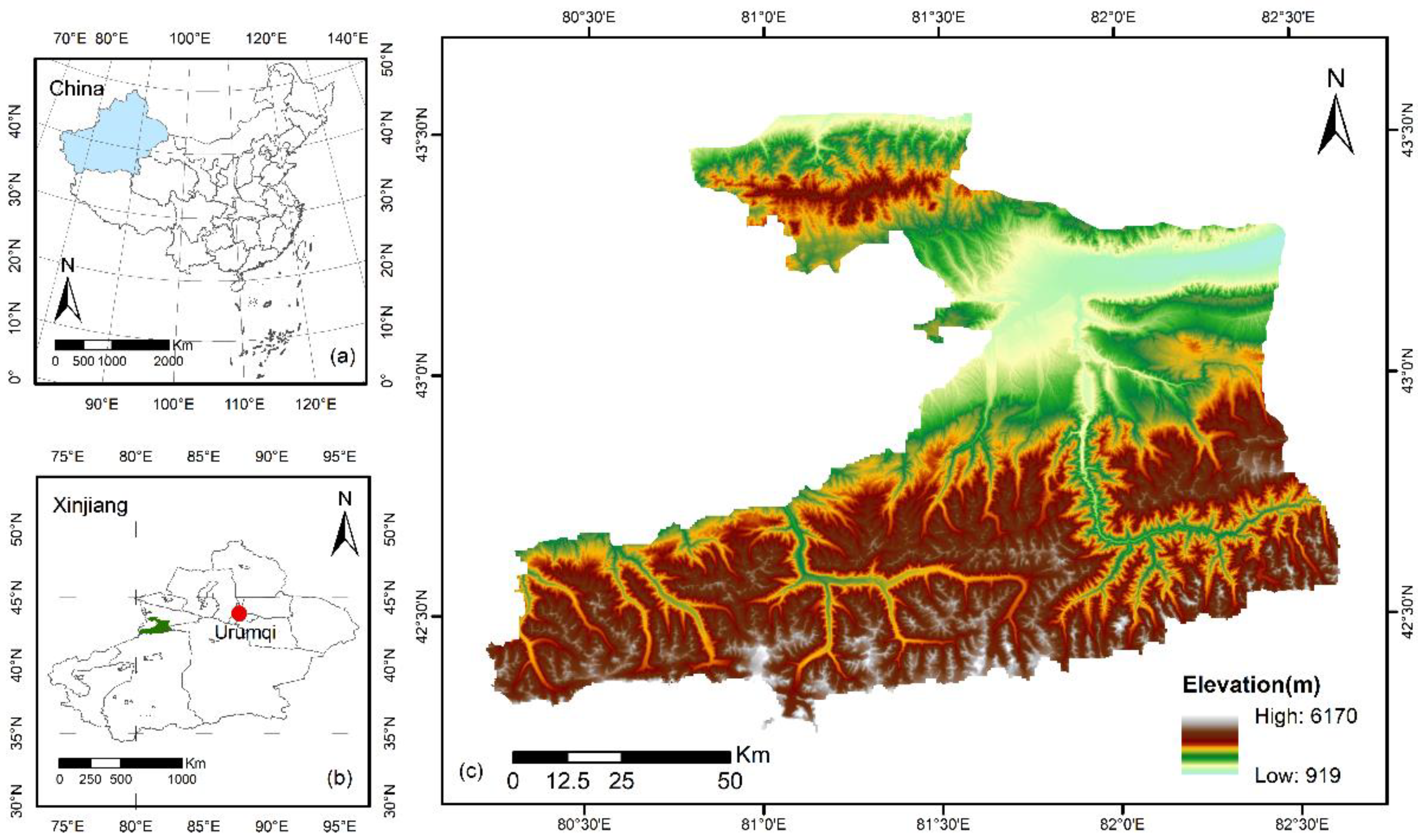
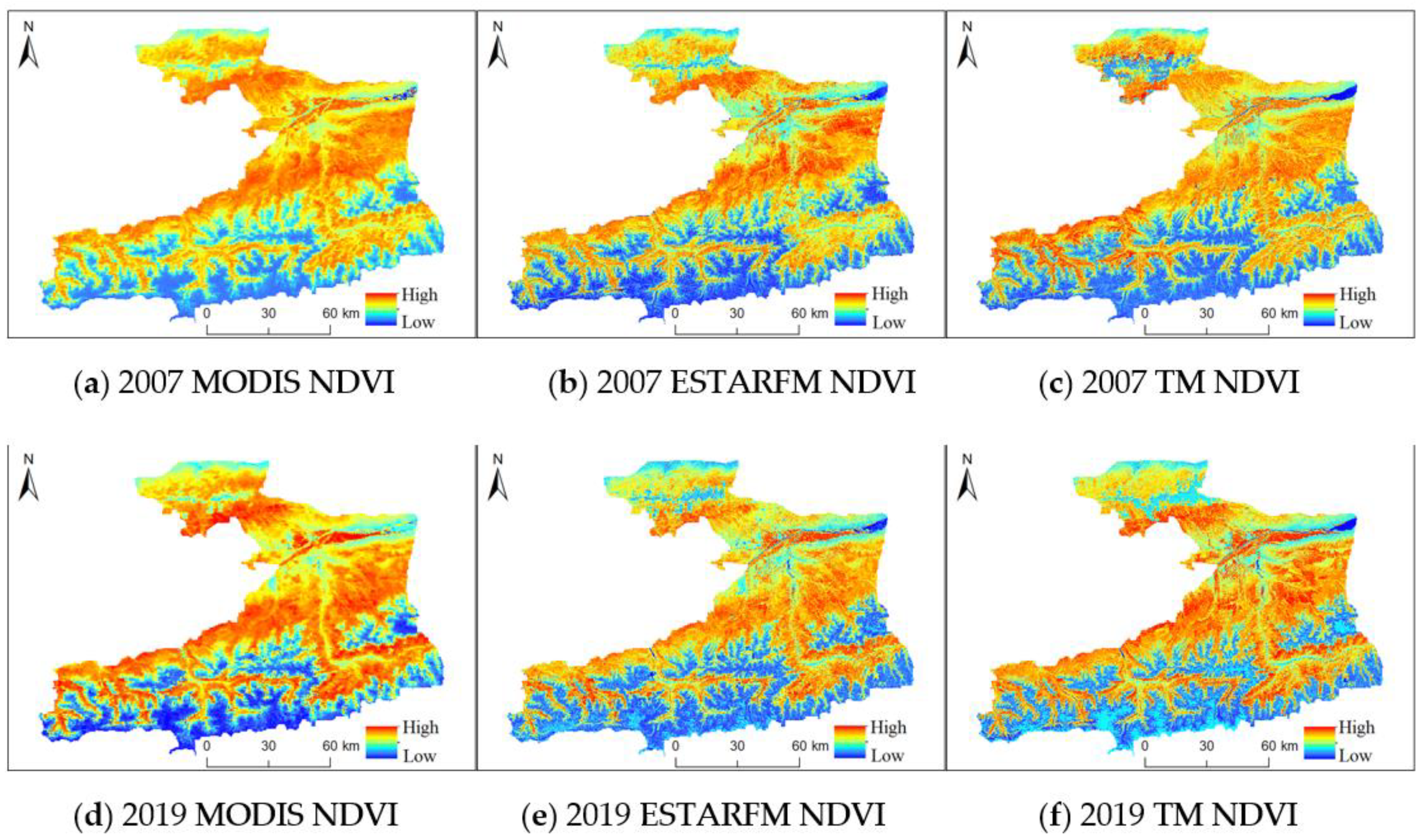

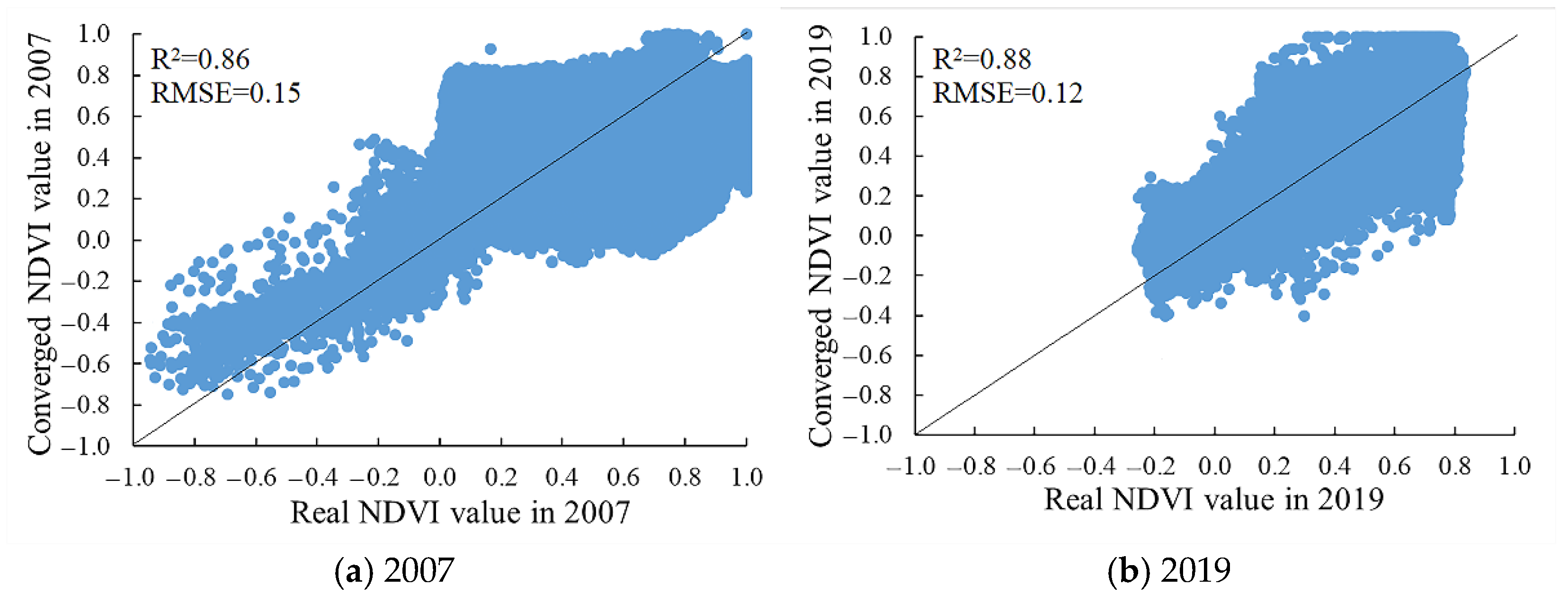

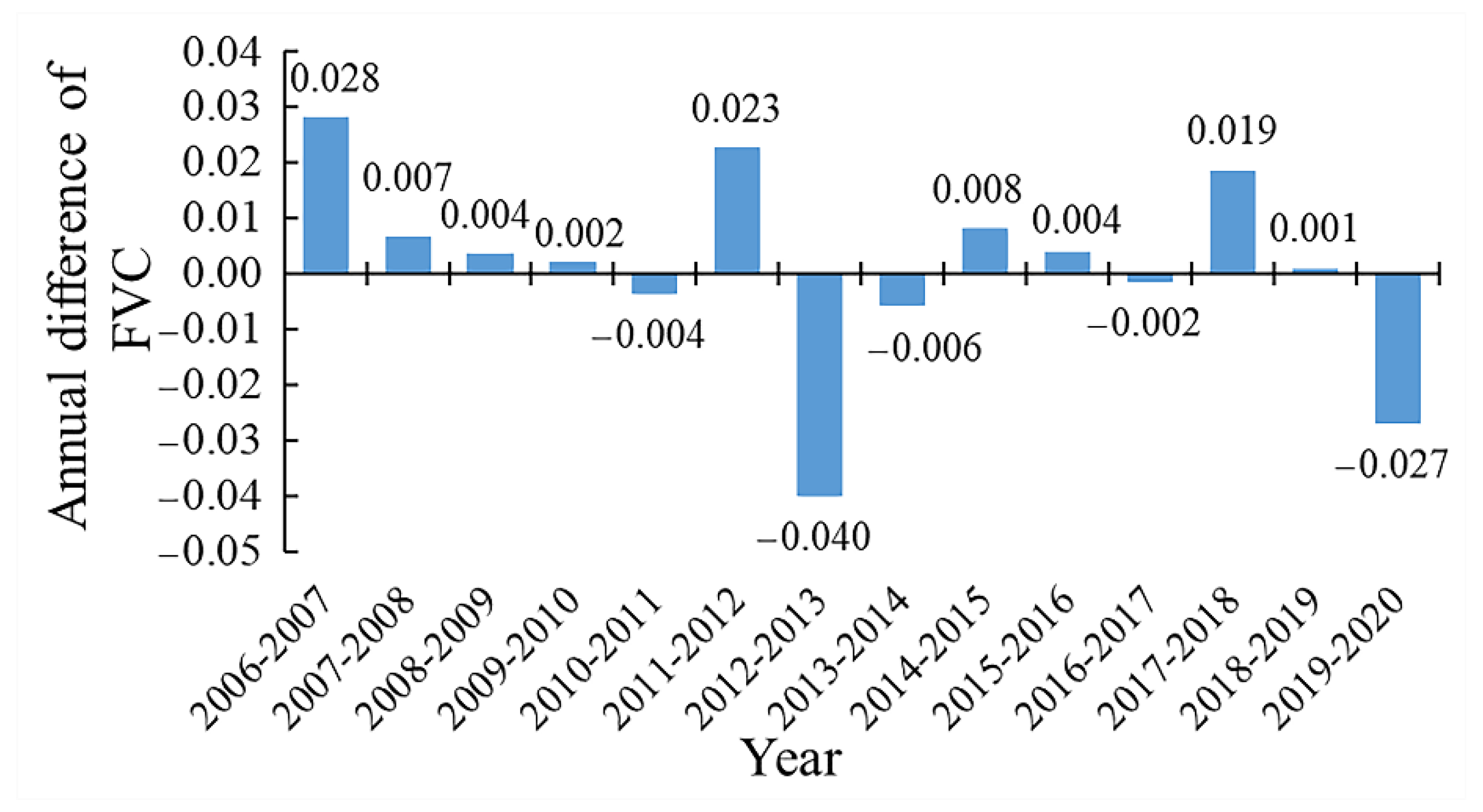

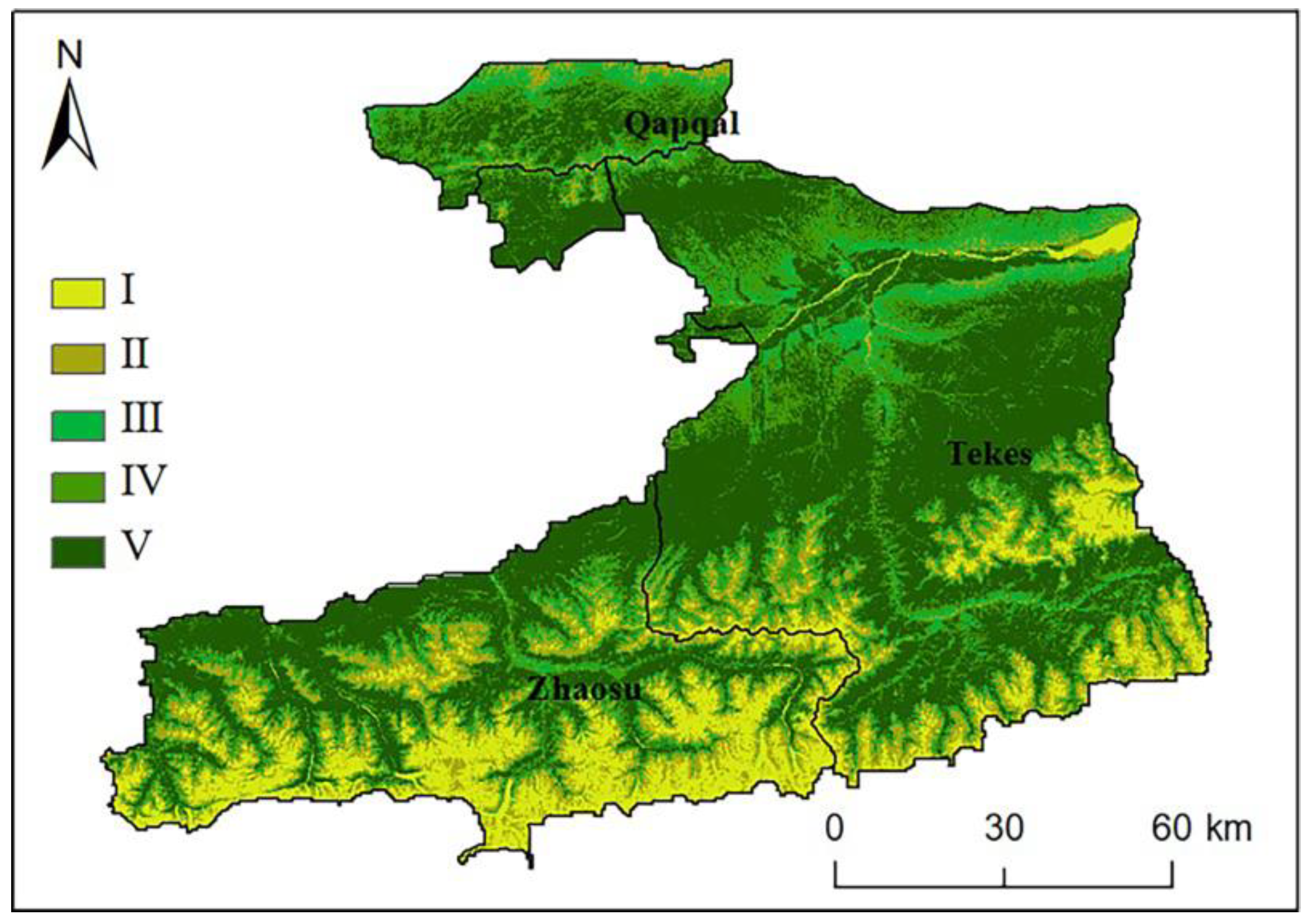




| Year | Forecast Date | Year | Forecast Date |
|---|---|---|---|
| 2007 (Experiment) | 08.13 | 2015 | 08.13 |
| 2009 | 08.13 | 2017 | 08.13 |
| 2010 | 08.13 | 2019 (Experiment) | 08.13 |
| Slope | Percentage/% | Significance | Percentage/% |
|---|---|---|---|
| Slope < −0.02 | 3.7% | Extremely significant decrease | 43% |
| −0.02 < Slope < −0.01 | 9.7% | Significant decrease | 2.1% |
| −0.01 < Slope < 0 | 34.3% | Insignificant change | 6% |
| 0 < Slope < 0.01 | 38% | Significant increase | 3.3% |
| 0.01 < Slope < 0.02 | 10.4% | Extremely significant increase | 45.6% |
| Slope > 0.02 | 3.9% |
Publisher’s Note: MDPI stays neutral with regard to jurisdictional claims in published maps and institutional affiliations. |
© 2022 by the authors. Licensee MDPI, Basel, Switzerland. This article is an open access article distributed under the terms and conditions of the Creative Commons Attribution (CC BY) license (https://creativecommons.org/licenses/by/4.0/).
Share and Cite
Liu, Z.; Chen, D.; Liu, S.; Feng, W.; Lai, F.; Li, H.; Zou, C.; Zhang, N.; Zan, M. Research on Vegetation Cover Changes in Arid and Semi-Arid Region Based on a Spatio-Temporal Fusion Model. Forests 2022, 13, 2066. https://doi.org/10.3390/f13122066
Liu Z, Chen D, Liu S, Feng W, Lai F, Li H, Zou C, Zhang N, Zan M. Research on Vegetation Cover Changes in Arid and Semi-Arid Region Based on a Spatio-Temporal Fusion Model. Forests. 2022; 13(12):2066. https://doi.org/10.3390/f13122066
Chicago/Turabian StyleLiu, Zhihong, Donghua Chen, Saisai Liu, Wutao Feng, Fengbing Lai, Hu Li, Chen Zou, Naiming Zhang, and Mei Zan. 2022. "Research on Vegetation Cover Changes in Arid and Semi-Arid Region Based on a Spatio-Temporal Fusion Model" Forests 13, no. 12: 2066. https://doi.org/10.3390/f13122066
APA StyleLiu, Z., Chen, D., Liu, S., Feng, W., Lai, F., Li, H., Zou, C., Zhang, N., & Zan, M. (2022). Research on Vegetation Cover Changes in Arid and Semi-Arid Region Based on a Spatio-Temporal Fusion Model. Forests, 13(12), 2066. https://doi.org/10.3390/f13122066








